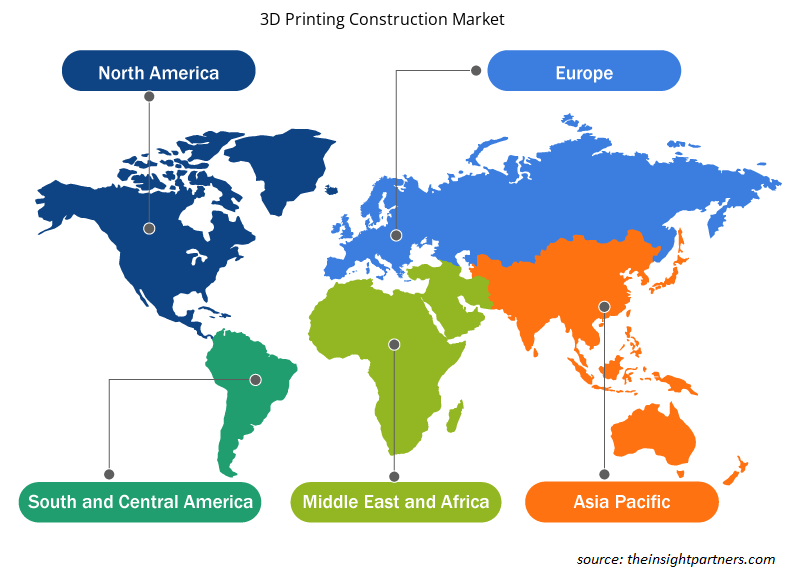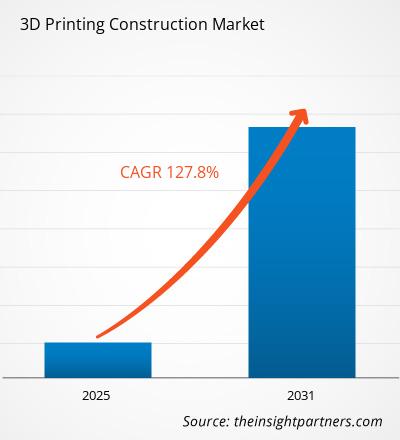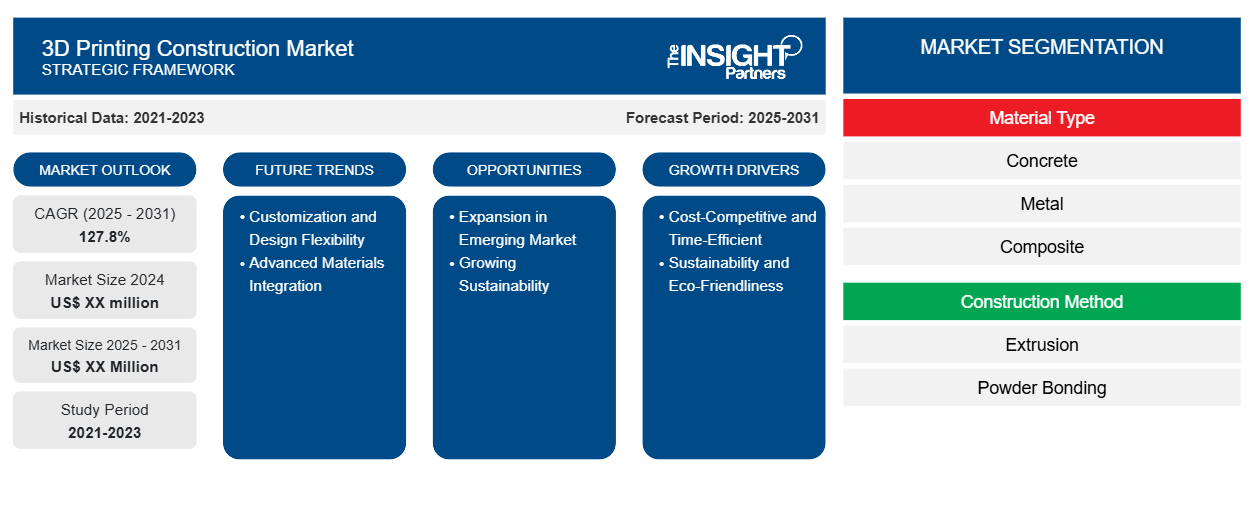من المتوقع أن يسجل سوق البناء بالطباعة ثلاثية الأبعاد معدل نمو سنوي مركب بنسبة 127.8٪ من عام 2023 إلى عام 2031، مع توسع حجم السوق من XX مليون دولار أمريكي في عام 2023 إلى XX مليون دولار أمريكي بحلول عام 2031.
تم تقسيم التقرير حسب نوع المادة (الخرسانة، المعدن، المركب، مواد أخرى)، طريقة البناء (البثق، الترابط بالمسحوق)، التطبيق (البناء، البنية التحتية)، الاستخدام النهائي (التجاري، السكني، الصناعي). تم تقسيم التحليل العالمي بشكل أكبر على المستوى الإقليمي والدول الرئيسية. يقدم التقرير القيمة بالدولار الأمريكي للتحليل والشرائح المذكورة أعلاه.
غرض التقرير
يهدف تقرير سوق البناء باستخدام الطباعة ثلاثية الأبعاد الصادر عن The Insight Partners إلى وصف المشهد الحالي والنمو المستقبلي وأهم العوامل الدافعة والتحديات والفرص. وسيوفر هذا رؤى لمختلف أصحاب المصلحة في الأعمال التجارية، مثل:
- مزودي/مصنعي التكنولوجيا: لفهم ديناميكيات السوق المتطورة ومعرفة فرص النمو المحتملة، وتمكينهم من اتخاذ قرارات استراتيجية مستنيرة.
- المستثمرون: إجراء تحليل شامل للاتجاهات فيما يتعلق بمعدل نمو السوق، وتوقعات السوق المالية، والفرص المتاحة عبر سلسلة القيمة.
- الهيئات التنظيمية: لتنظيم السياسات ومراقبة الأنشطة في السوق بهدف تقليل الانتهاكات والحفاظ على ثقة المستثمرين والحفاظ على سلامة السوق واستقرارها.
تجزئة سوق الطباعة ثلاثية الأبعاد للبناء
نوع المادة
- أسمنت
- معدن
- مركب
- آحرون
طريقة البناء
- البثق
- مسحوق الربط
طلب
- مبنى
- بنية تحتية
الاستخدام النهائي
- تجاري
- سكني
- صناعي
الاستخدام النهائي
- تجاري
- سكني
- صناعي
قم بتخصيص هذا التقرير ليناسب متطلباتك
ستحصل على تخصيص لأي تقرير - مجانًا - بما في ذلك أجزاء من هذا التقرير، أو تحليل على مستوى الدولة، وحزمة بيانات Excel، بالإضافة إلى الاستفادة من العروض والخصومات الرائعة للشركات الناشئة والجامعات
- احصل على أهم اتجاهات السوق الرئيسية لهذا التقرير.ستتضمن هذه العينة المجانية تحليلاً للبيانات، بدءًا من اتجاهات السوق وحتى التقديرات والتوقعات.
محركات نمو سوق الطباعة ثلاثية الأبعاد في مجال البناء
- تنافسية من حيث التكلفة وفعّالة من حيث الوقت: يعد التوفير الكبير في نفقات البناء وكذلك الوقت من بين العوامل الرئيسية في قطاع البناء في أسواق الطباعة ثلاثية الأبعاد. مع الطباعة ثلاثية الأبعاد، يكون الهيكل الذي يتم بناؤه آليًا للغاية مع استغراق وقت أقل بكثير وبالتالي قد تكون تكاليف العمالة أقل مع القليل من الخسارة في المواد.
- الاستدامة والصديقة للبيئة: إن القوة الدافعة الرئيسية الأخرى تكمن في السعي إلى البناء المستدام. ويمكن تحقيق ذلك من خلال استخدام مواد صديقة للبيئة وتقليل النفايات، مع مراعاة أهداف الاستدامة العالمية. وهذا اتجاه مهم لأنه يأتي في وقت تواجه فيه صناعة البناء المزيد من الضغوط لتقليل مستوى تأثيرها البيئي.
اتجاهات مستقبلية في سوق الطباعة ثلاثية الأبعاد في مجال البناء
- التخصيص ومرونة التصميم: يمكن التخصيص في مشروع البناء باستخدام الطباعة ثلاثية الأبعاد إلى أقصى حد. تساعد هذه القدرة على التكيف المهندسين المعماريين والبنائين على تصميم عمارة فريدة لتلبية جميع احتياجات العميل في السوق لتمييزهم عن الآخرين.
- دمج المواد المتقدمة: المواد المتقدمة، التي يتم إنتاجها خصيصًا للطباعة ثلاثية الأبعاد في البناء، متطورة للغاية ويتم استخدامها. يمهد المزيد من البحث في علم المواد الطريق لخيارات أقوى وأكثر متانة توفر المزيد من الاستدامة. وهذا يخلق قدرات وتطبيقات محسنة في مشاريع البناء باستخدام الطباعة ثلاثية الأبعاد.
فرص سوق الطباعة ثلاثية الأبعاد في مجال البناء
- التوسع في الأسواق الناشئة: من المتوقع أن يؤدي التوسع المتزايد في الأسواق الناشئة بسبب التطور المتزايد في قطاع البناء إلى دفع نمو السوق.
- الاستدامة المتنامية: من المتوقع أن يؤدي التركيز المتزايد على الاستدامة والطلب المتزايد على الأساليب المستدامة والصديقة للبيئة في قطاع البناء إلى دفع نمو السوق.
رؤى إقليمية حول سوق الطباعة ثلاثية الأبعاد في مجال البناء
لقد قام المحللون في Insight Partners بشرح الاتجاهات والعوامل الإقليمية المؤثرة على سوق البناء بالطباعة ثلاثية الأبعاد طوال فترة التوقعات بشكل شامل. يناقش هذا القسم أيضًا قطاعات سوق البناء بالطباعة ثلاثية الأبعاد والجغرافيا في جميع أنحاء أمريكا الشمالية وأوروبا ومنطقة آسيا والمحيط الهادئ والشرق الأوسط وأفريقيا وأمريكا الجنوبية والوسطى.

- احصل على البيانات الإقليمية المحددة لسوق البناء باستخدام الطباعة ثلاثية الأبعاد
نطاق تقرير سوق البناء باستخدام الطباعة ثلاثية الأبعاد
| سمة التقرير | تفاصيل |
|---|---|
| حجم السوق في عام 2023 | XX مليون دولار أمريكي |
| حجم السوق بحلول عام 2031 | XX مليون دولار أمريكي |
| معدل النمو السنوي المركب العالمي (2023 - 2031) | 127.8% |
| البيانات التاريخية | 2021-2022 |
| فترة التنبؤ | 2024-2031 |
| القطاعات المغطاة | حسب نوع المادة
|
| المناطق والدول المغطاة | أمريكا الشمالية
|
| قادة السوق وملفات تعريف الشركات الرئيسية |
|
كثافة اللاعبين في سوق الطباعة ثلاثية الأبعاد في مجال البناء: فهم تأثيرها على ديناميكيات الأعمال
يشهد سوق البناء باستخدام الطباعة ثلاثية الأبعاد نموًا سريعًا، مدفوعًا بالطلب المتزايد من المستخدم النهائي بسبب عوامل مثل تفضيلات المستهلكين المتطورة والتقدم التكنولوجي والوعي المتزايد بفوائد المنتج. ومع ارتفاع الطلب، تعمل الشركات على توسيع عروضها والابتكار لتلبية احتياجات المستهلكين والاستفادة من الاتجاهات الناشئة، مما يؤدي إلى زيادة نمو السوق.
تشير كثافة اللاعبين في السوق إلى توزيع الشركات أو المؤسسات العاملة في سوق أو صناعة معينة. وهي تشير إلى عدد المنافسين (اللاعبين في السوق) الموجودين في مساحة سوق معينة نسبة إلى حجمها أو قيمتها السوقية الإجمالية.
الشركات الرئيسية العاملة في سوق البناء بالطباعة ثلاثية الأبعاد هي:
- أبيس كور
- صناعة الخطوط العريضة
- Csp SRL (سنترو سفيلبو بروجيتي)
- سايبى للإنشاءات
- رمز
إخلاء المسؤولية : الشركات المذكورة أعلاه ليست مرتبة بأي ترتيب معين.

- احصل على نظرة عامة على أهم اللاعبين الرئيسيين في سوق البناء بالطباعة ثلاثية الأبعاد
نقاط البيع الرئيسية
- التغطية الشاملة: يغطي التقرير بشكل شامل تحليل المنتجات والخدمات والأنواع والمستخدمين النهائيين لسوق البناء بالطباعة ثلاثية الأبعاد، مما يوفر صورة شاملة.
- تحليل الخبراء: تم تجميع التقرير على أساس الفهم العميق لخبراء الصناعة والمحللين.
- معلومات محدثة: يضمن التقرير أهمية الأعمال التجارية بسبب تغطيته للمعلومات الحديثة واتجاهات البيانات.
- خيارات التخصيص: يمكن تخصيص هذا التقرير لتلبية متطلبات العملاء المحددة وبما يتناسب مع استراتيجيات العمل بشكل مناسب.
وبالتالي، يمكن أن يساعد تقرير البحث حول سوق البناء باستخدام الطباعة ثلاثية الأبعاد في تمهيد الطريق لفك شفرة وفهم سيناريو الصناعة وآفاق النمو. ورغم وجود بعض المخاوف المشروعة، فإن الفوائد الإجمالية لهذا التقرير تميل إلى التفوق على العيوب.
- التحليل التاريخي (سنتان)، سنة الأساس، التوقعات (7 سنوات) مع معدل النمو السنوي المركب
- تحليل PEST و SWOT
- حجم السوق والقيمة / الحجم - عالمي، إقليمي، بلد
- الصناعة والمنافسة
- مجموعة بيانات إكسل
التقارير الحديثة
تقارير ذات صلة
شهادات العملاء
سبب الشراء
- اتخاذ قرارات مدروسة
- فهم ديناميكيات السوق
- تحليل المنافسة
- رؤى العملاء
- توقعات السوق
- تخفيف المخاطر
- التخطيط الاستراتيجي
- مبررات الاستثمار
- تحديد الأسواق الناشئة
- تحسين استراتيجيات التسويق
- تعزيز الكفاءة التشغيلية
- مواكبة التوجهات التنظيمية





















 احصل على عينة مجانية ل - سوق البناء بالطباعة ثلاثية الأبعاد
احصل على عينة مجانية ل - سوق البناء بالطباعة ثلاثية الأبعاد